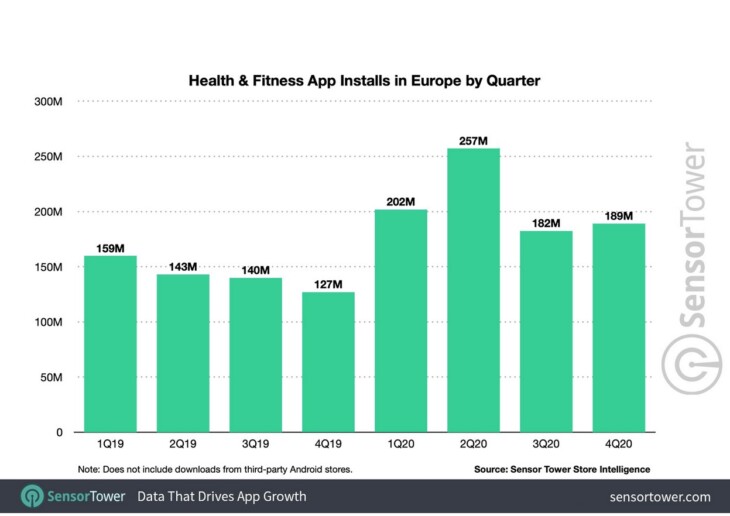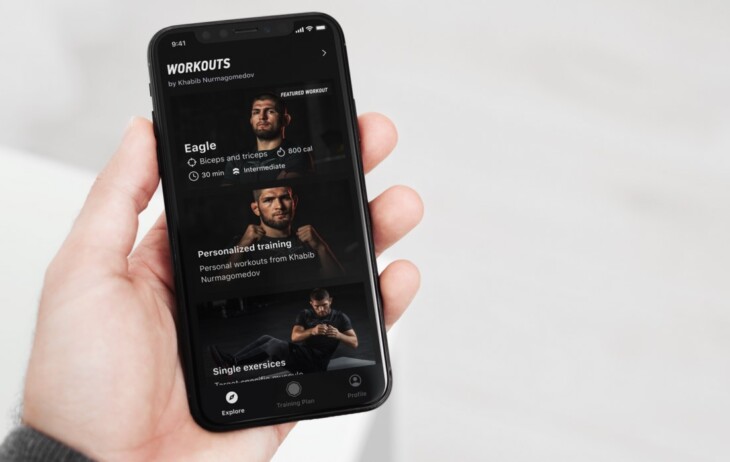Forced indoors through lockdowns and social distancing measures, an unprecedented number of consumers have been turning to their smartphone apps to help them keep fit, stay healthy and practice mindfulness.
In Europe, downloads of apps categorized as ‘health and fitness’ by its developers reached 829.5 million in 2024 – a 46% rise on the year before, according to Store Intelligence data conducted by Sensor Tower. This increase is made all the more remarkable when considering the 568.6 million downloads that took place in 2019 only represented a 7.4% year-on-year increase.
The rate of downloads peaked in the second quarter of 2024, as the pandemic forced much of Europe into deep lockdowns in a bid to prevent the spread. Although installs cooled throughout the rest of the year, they never fell below their highest peaks in 2019.
The key apps that benefited from this new health-conscious market included fitness social media apps, Strava and mindfulness apps like Calm and Headspace. The biggest spending market within Europe was the nation that suffered the most on a humanitarian and economic level in the wake of the pandemic, the UK – which commanded 29.5% of total downloads, while the likes of Germany and France were second and third respectively with 16.4% and 10.4% of the downloads.
The rise of the health and fitness market has offered up some significant opportunities to companies that can potentially incorporate innovative technology into their apps to provide market-leading insights. One app that looks ready to utilize algorithmic technology to generate a premium quality service to audiences who are increasingly receptive to self-improvement is OctaZone, spearheaded by mixed martial arts and UFC athlete, Khabib Nurmagomedov.
In a world that’s become increasingly remote over the past year, let’s take a deeper look into how apps are utilizing new technology to bring fitness to an isolated audience:

Image: Sensor Tower
Fitness Apps Leading Engagement in Isolation
Despite the Coronavirus pandemic being a time of significant difficulty for individuals around the world, it’s also provided users with the opportunity to work on some self-improvement.
“Covid-19 has presented many people with the unique opportunity to exercise more, because, practically, people have fewer reasons not to. If nothing else, exercise outdoors provides us with some welcome relief from spending so much time indoors during lockdown,” explained Dr Charlotte Hilton, of the British Psychological Society.
“However, because of the social restrictions that Covid-19 brings, more people may be turning to online exercise communities and apps to enhance their connectedness to other like-minded people who enjoy exercise,” Hilton added.
As one of the biggest beneficiaries of the pandemic’s effect on people’s motivation towards exercise apps, Strava saw higher volumes of activity logged on the app – especially in the case of running and cycling. In fact, those using the app increased the rate of their workouts by 13% over the course of the pandemic.
Interestingly, the app became a way of users to communicate with each other, with a spike in online activity clubs created within the app and a record number of runners completing the app’s 5-kilometre challenge in May 2024.
AI-Driven Fitness
Machine learning and artificial intelligence can play a key role in modern fitness platforms, and advancing technology means that these benefits aren’t just showcased in high-end programs.
Many cost-effective apps like FitnessAI, an app that claims to possess an algorithm that’s been trained on nearly six-million workouts and boldly claims to “outperform any human personal trainer.”
Other apps like Freeletics utilizes machine learning to better understand a user’s health and create a unique program for them based on 3.5 million possible combinations. This level of technology is important today. While physical activity is vital for fitness and wellness, the ability of apps to track how users feel about their routines and options can often be just as vital – because it can play a significant role in ensuring continued motivation.
This greater level of personalization and focus on ensuring that users continue enjoying fitness apps may ultimately decide on the long-term success of these innovative fitness platforms. COVID-19 may have forced gyms around the world to close – forcing users to turn to their fitness apps more, but while gyms can be an intimidating place for trainers, apps that offer bespoke programs and personalized encouragement could see more users saving money on their memberships and going mobile with their approach to fitness.

The Next Generation of Fitness App
The recent addition of OctaZone, former UFC fighter, Khabib Nurmagomedov’s fitness app, looks to utilize algorithmic technology to create highly personalized and engaging workouts for users that are designed to lose weight and optimize the areas of the body that are most sought after.
The pricing works like a subscription with $9.99 per month, or $59.99 per year, making this app is a mid-range entry onto the market place. Committed exercise enthusiasts can also access a lifetime subscription to the app for $129 – however, this offer is discreetly located outside of the app itself and can be redeemed via their subscriptions settings on their iPhone. Unlocking lifetime access gives users the ability to access all of the app’s features and dynamic, tailored workouts without having to set up a recurring purchase.
As rapid weight loss is a key part of Khabib’s preparation throughout his life as a UFC fighter, his knowledge has been poured into the app. To prepare for fights, the MMA icon continually lost 10 kilos ahead of 47 bouts and has safely transferred his expertise, experience and passion into the OctaZone smart training platform. Without the measures that Nurmagomedov has placed within his app, the UFC landscape may have looked very different.
One of the main characteristics of the app is the level of personalization. Users can access tailor suited workouts that are created wholly based on the data that’s shared regarding the age, weight, height, fitness level and goals of the trainer.
In a post-COVID landscape where fitness apps may continue to gain ground on gyms, we may be seeing the development of the next generation of apps to help us stay more motivated and workout more efficiently.
